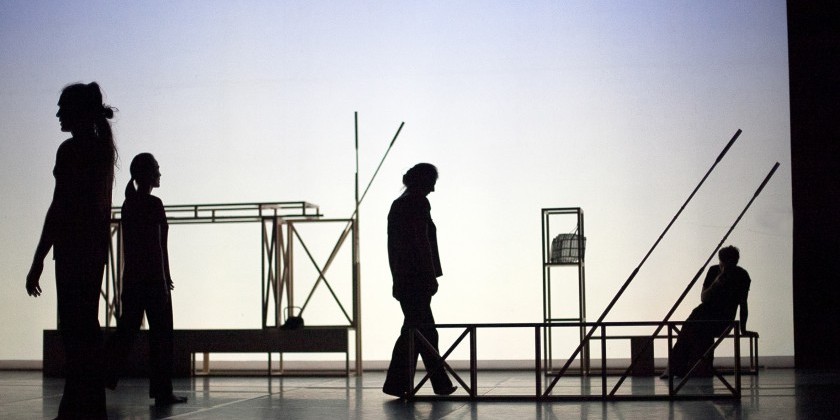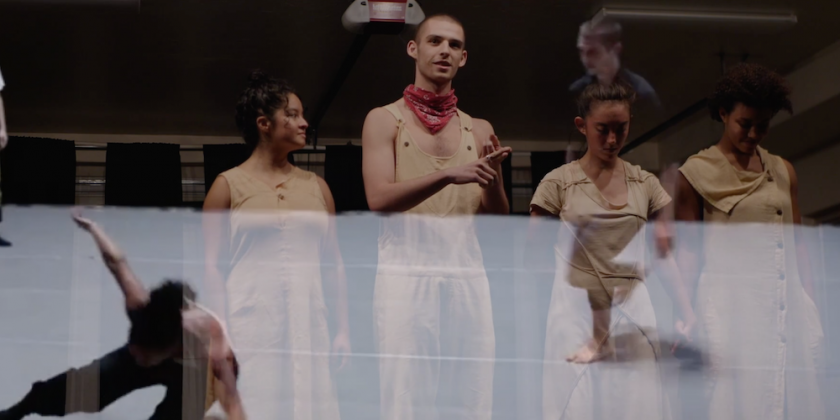Impressions from France: The House of Hermès’ "New Settings"

Across The Pond- Dance, Art, and a Fashion House Collaborate
Presented at Théâtre de la Cité internationale, Paris
November 3-15, 2014
“A business generating nothing but profits is poor indeed.” - Pierre Alexis Dumas, President of the Fondation d’entreprise Hermès
The luxury designer House of Hermès supported dance and music long before their foundation, Fondation d’entreprise Hermès, was established in 2008. The foundation’s Director, Catherine Tsekenis, says that they have always had a tendency to fund performance projects that incorporate the visual arts and design.
One of the foundation’s many programs, New Settings, supports performance projects that bring visual and performing artists together in what we in the US would refer to as “a collaboration.” The aim is to expose these artists to new skills, to “spark a dialogue between their creative processes” and enable new forms to emerge. The criterion is excellence.
I went to see each of the five works that were funded this year, two of which involved dance. Too often, it seemed like one of the artists was driving the work while the other artist was “put to use.” But it is worth noting that “teamwork” is not among the skills one typically learns here in France. And the word “collaboration” is colored with strongly negative memories of Nazi ‘cooperation’ during WWII. In all of the written material on New Settings there is not one reference to artistic collaboration, and yet, from a US-based English language perspective, this is what New Settings is all about: coming together as a team with diverse skills to explore and create new works and new forms.
Collaboration in the positive sense of the word is about taking risks and stepping out into unknown territory together. It means bringing our expertise to the table, but not having all of the answers. It means exploring the questions and being willing to listen to and be affected by one another.

In La Tentation d’un hermitage (The Temptation of a Hermitage) by the dance-design team, Hervé Robbe and Benjamin Graindorge, Robbe was exploring emotional isolation. His relationship to the sets is sterile and utilitarian. The dancers’ loose-jointed movements are smooth, graceful and easy, but their only connection to Graindorge’s plywood frames is to move them from one place to another, setting themselves amidst the illusion of tables, chairs and cabins. They pound long sticks on the floor and reinsert them into the shifting environment. They put headdresses on and take them off again. But there is no synergy. One form does not enhance the other in any significant way.
I was frustrated. Graindorge’s set is a feast of geometric lines and empty spaces — rectangular nooks, triangular cocoons, square supports. It must have taken a concerted effort not to be moved or affected by them. But Robbe seemed determined to keep the design in service of whatever idea he held so firmly in his head.

The performative installation, Abysse, by the dance-visual arts team Sylvain Prunenec and Clédat & Petitpierre, was on exhibit in the theatre lobby on my first visit, and in front of the theatre entrance on my second. Prunenec was immersed in a brown-orange fabric of filaments, and nested in a black stand-alone sculpture. Even the smallest of movements, a simple breath, sent the tentacles a-wave. He seemed like a sea anemone in the ocean, but that was all. As a performance work it just didn’t hold up.

New Settings, now in its fourth year, came into being as a partnership with Théâtre de la Cité international, under the Direction of Pascale Henrot. More recently, the French Institute–Alliance Française (FIAF) has joined forces to extend the reach of some of these works through its festival, Crossing the Line in New York City. It is unusual to find government-funded organizations, like the Théâtre and FIAF, working together with a corporate foundation. Business here is looked upon with suspicion. I would say that while some of the artists might not be up to a real collaborative venture, these two women and the committee they have created to run this program certainly are.
I asked Ms. Tsekenis how the group measured success. She said they deem it successful when the work is a shared creation by two artists who are open to learning new skills and new ways of working. Public recognition, in the form of ticket sales, applause and press coverage contribute as well. Finally, work is successful when the it continues out into the world on tour, or the artists continue to create together in the future.
The core conviction expressed at the Fondation d’entreprise Hermès is that “nos gestes nous créent,” which they translate as “our gestures define us.”**
I applaud their willingness to take the risks needed to challenge artists to work together, to push beyond comfort zones and assumptions so that new forms and ideas can be born.
**implying not simply ‘gestures,’ but our actions in the world.) Supporting excellence, encouraging creativity, and passing skills on to future generations are the ‘gestures’ that define Hermès today. And they seem to be living up to Mr. Dumas statement that “A truly ‘rich’ company commits to the growth of its cultural and human wealth” too.














